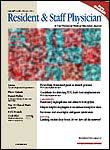Publication
Article
Resident & Staff Physician®
Alcohol Consumption Again Linked to Increased AFib Risk
Author(s):
Chronic alcohol consumption of 2 or more drinks per day is associated with up to 30% higher risk for atrial fibrillation.
New analysis of patient records from the Framingham Heart Study quantifies the association between increasing alcohol consumption, left atrial enlargement and subsequent atrial fibrillation (AF).
Investigators used outcome data from 5,220 study participants whose records included regular echocardiographic left atrial size measurements. Over a median follow-up period of 6.0 years (25th-75th percentiles, 4.0 years to 8.7 years), 1,088 members of the cohort were diagnosed with incident AF, a rate of 8.4 cases per 1,000 person-years.
After multivariable adjustment for potential confounders, each additional 10 g of alcohol per day — an amount just under 1 additional drink per day — was associated with 0.16 mm greater left atrial diameter (95% confidence interval [CI], 0.10 mm to 0.21 mm). The same adjusted analysis also found that every additional 10 g of alcohol per day was associated with a 5% greater risk of incident AF (95% CI, 1.01-1.09). An estimated 24% of the association between alcohol consumption and AF risk was explained by left atrial enlargement (95% CI, 8%-75%).
“Acute alcohol consumption has long been linked to development of AF. In the Framingham, Copenhagen, and Women's Health Studies, chronic alcohol consumption, especially 2 or more drinks per day, is associated with up to 30% higher risk for incident AF,” the study authors wrote in the Journal of the American Heart Association. “Our study is novel in that it leveraged the serial assessments of left atrium size and alcohol consumption as part of the Framingham Heart Study to conduct a comprehensive assessment of the relations between fluctuating levels of alcohol consumption and left atrial diameter change over time.”
Although the investigators identified a few potential weaknesses in their study — factors such as the possibility that some cases of AF went undetected — they believe the size of the cohort, the constitution of the cohort and the quality of records kept for the Framingham Heart Study make for very strong conclusions.
The cohort was 54% female and, at baseline, its members had a mean age of 56.3 years and a mean left atrial diameter of 38.3 mm (± a standard deviation of 5.4 mm). They reported, on average, alcohol consumption of 13.3 g/day (± 16.7 grams per day), and most of them remained free of any type of cardiovascular disease throughout the follow-up period.
The authors of the new study believe that although their analysis provides substantial information about how much an increase in total alcohol consumption will typically increase the risk of incident AF, much important work remains to be done.
“Understanding the mechanisms underlying the relationships between alcohol and AF is important for several reasons,” the study authors wrote. “First, some patients may benefit from moderate consumption of alcohol, and identifying those at risk for cardiovascularâ€system harm (such as given evidence of left atrium enlargement) may help to counsel patients regarding their specific risks versus benefits appropriately. Second, as the etiology of AF remains incompletely understood in the majority of patients, identifying mechanisms of known risk factors might help to reveal new therapeutic targets. Third, as alcohol may represent a modifiable risk factor for AF, elucidating the nature by which the substance may enhance AF risk is important.”
